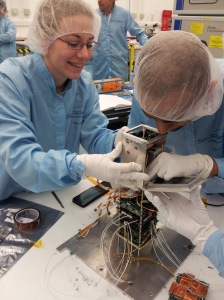 On January 18, 2019, NEXUS was launched on an Epsilon launch vehicle from the JAXA Uchinoura Space Center in Japan.
On January 18, 2019, NEXUS was launched on an Epsilon launch vehicle from the JAXA Uchinoura Space Center in Japan.
NEXUS (NExt generation X Unique Satellite) is a satellite developed jointly by Nihon University College of Science and Technology and the Japan Amateur Satellite Association (JAMSAT).
NEXUS demonstrates several new amateur satellite communication technologies, and includes a mode V/u linear transponder.
Telemetry has been received and decoded around the world since the launch, and the transponder was successfully tested on January 26th.
More information may be found at
http://sat.aero.cst.nihon-u.ac.jp/nexus/E0_Top.html
At the request of the Nihon University College of Science and Technology and JAMSAT, AMSAT hereby designates NEXUS as Fuji-OSCAR 99 (FO-99). We congratulate the owners and operators of FO-99, thank them for their contribution to the amateur satellite community, and wish them continued success on this and future projects.
73, Drew Glasbrenner, KO4MA
AMSAT VP Operations / OSCAR Number Administrator
Frequencies:
• 437.075 MHz CW Telemetry
• 435.900 MHz FSK AX.25 / π/4 shift QPSK CCSDS
• SSB/CW transponder
– 145.900-145.930 MHz Uplink
– 435.880-435.910 MHz Downlink
NEXUS Blog http://tinyurl.com/NEXUS-Sat-Blog
JAMSAT in Google English http://tinyurl.com/JAMSAT
IARU Frequency Coordination http://www.amsatuk.me.uk/iaru/finished_detail.php?serialnum=535







You must be logged in to post a comment.